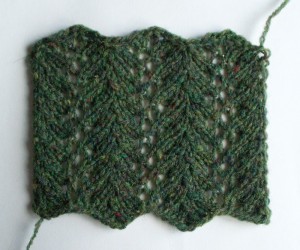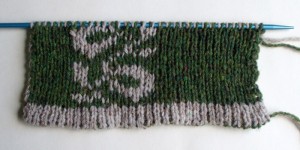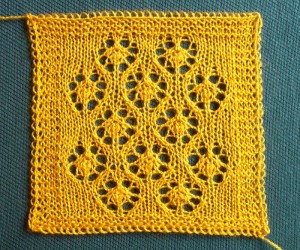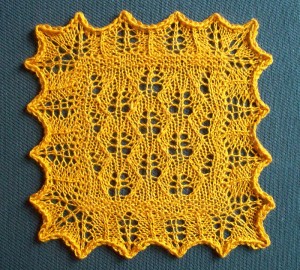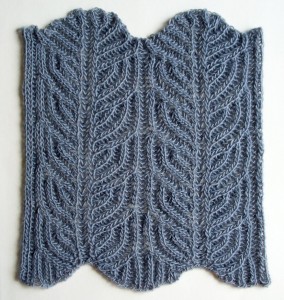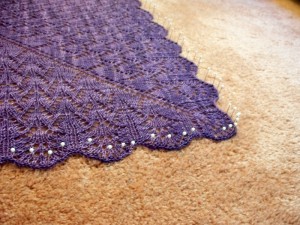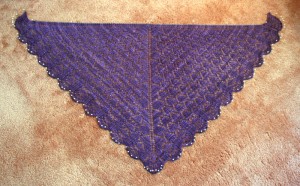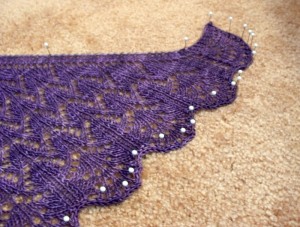A couple weeks back, my laptop went kaput. No coaxing from the local Mac doctor could revive it. I was told that replacing the hard drive (to the tune of about $250, installed) would make it functional again, but I took the sudden death as A Sign: after four years, it was time to ditch my dented, second-hand MacBook Pro and get a new laptop. More to the point: I had an excuse to get a MacBook Air, something I’d lusted after ever since the I first saw a TV ad with one being seductively pulled out of a slim manilla envelope.
You see, I travel with my laptop. And the old MacBook Pro was heavy. In comparison? The Air is tiny.
Oh, yes, I love me my new laptop. Lighter and faster than the old behemoth.
The “gotcha!” is that the new laptop practically swims in the padded compartment of my old laptop bag. And that got me thinking. Wouldn’t it be fun to make a padded sleeve for the laptop? Maybe quilted, or – better yet! – knit and felted. Yes, that was it: out of Lamb’s Pride in my stash, with fat cables for textural interest.
With great excitement, I related these ideas to Da Hubster. His response: “Why don’t you just buy a padded sleeve?”
Yes, you guessed right, folks: DH is not a crafty dude.
Why make something you can buy? Because it’s fun to envision something unique, then make it a reality. Because it’s a chance to exercise hands-on skills. Because it’s a way of getting what you really want, instead of settling for what’s available in stores.
Because I can.
So I’ve pulled a couple skeins of Lamb’s Pride out of the stash. And I’ve thumbed through some stitch dictionaries, bookmarking cable patterns with promise. Next up: knitting and felting a few swatches. It ought be fun. It won’t be complete before my next trip, though: first thing tomorrow morning, I leave for Stitches Midwest. Whoo hoo! Hope to see you there!
Lately I haven’t been knitting much because another project has grabbed all my interest, but I still need to have something on my needles, you know? So I’m futzing around with a crescent-shaped shawlette. The idea is to have a pretty scalloped pattern along the bottom edge – namely, this one:
– and to fill in the rest with simple garter stitch, shaping with short rows and maybe decreases.
The “gotcha!” is knitting the shawlette lengthwise, from the bottom up, to get the stitch pattern oriented the way I want. This meant casting on 463 stitches. Sure, the short-row shaping means the rows are getting shorter… but still, my progress has been slow.
And my progress is about to get slower. I realized late last night (why do these realizations always occur late at night??) that I had ceased to read the chart I’d created for myself, and had knit several rows on auto-pilot.
If you look at my original swatch, you’ll see a three-row sequence (a purl ridge, yo/k2tog eyelets, and another purl ridge) that’s worked a total of four times: twice near the bottom, and twice near the top.
And if you look closely at the WIP, you’ll see that the third sequence is differs from the others. Its yo are clustered near the center of each scallop repeat, instead of distributed evenly throughout.
Pfft.
Fixing this goof will mean ripping back several rows. It’s gonna be tedious.
Then again…
I’m just futzing around with this shawlette, right? No-one says I have to knit it as originally planned. Maybe this would be a good chance to practice deviating from Plan A – something I ordinarily find rather difficult to do.
Besides. I think I kind of like the auto-pilot variation.
Staying power
By JC | June 28, 2012
Whee! Unicorn just released its TNNA Top Books list, the list of bestselling books at the industry’s top trade show. Charts Made Simple ranked as #8, after being out for over a year! Now that’s some staying power. 🙂
Several other publications from Visionary Authors also made the list, including five of the top ten. Talk about a vote of confidence for self-publishing!
I’m thrilled by the support Unicorn has given to the Visionary Authors, and by the reception our books have received in the marketplace. But truthfully? I’m especially thrilled when I hear that a knitter has actually read my book. For too long, I’d meet up with knitters at teaching gigs and hear them say they’d bought but not yet read Charts Made Simple. Lately, though, I hear comments like, “It’s changed my knitting!” and “Now I seek out patterns with charts.” Ah, that’s so good to hear.
Last month while at Churchmouse I scored a couple skeins of Loft:
Oh, such lovely stuff. For a month, those skeins sat on my coffee table where I could pet them daily, and imagine what they might become.
Last week I finally wound them into balls, and got started swatching. First up, basic garter and stockinette stitch:
I often do a swatch like this one, when I’m just getting to know a new-to-me yarn. Starting with a single stitch and working a kfb increase at the beginning of each row means I don’t have to think about how many stitches to cast on – rather, I just keep increasing until it’s “big enough.” Working in garter and then in stockinette (and then in seed stitch or tweed stitch, if I feel like it) gives me a decent idea of how the yarn behaves.
And I like how Loft behaves. Being tweedy and a bit rustic, it begs for colorwork. Yet some lace samples at Churchmouse intrigued me. I had to try at least one lace swatch:
This I kind of like. Maybe I’ll work lace out of some future skeins of Loft. These skeins, though, really want to be colorwork.
But what kind of colorwork? Simple garter stripes, perhaps in a hat where the rows ran vertically, would be really effective.
Sadly, however, I can rarely muster proper appreciation for simple designs; it’s the more involved ones that always grab my interest. Case in point: a scarf worked in double knitting, with a floral motif running the length of the scarf:
Mm, I really like this concept. But this specific design? Not so much: the petals/flowers are fine, but the leaves and vines are so small and delicate that they kind of get lost. And the design is fiddly. The pattern isn’t easy to memorize, so I have to refer to the chart for every row. Blech! Part of why I love charts is that they often let me memorize a stitch pattern before I’ve finished working the first repeat, letting me set the chart aside and knit on blissfully. Not this stitch pattern: I’m tied to the chart, and I don’t care for that.
So where does that leave me? Right now, I’m thinking I’ll restart the scarf using a simpler, bolder stitch pattern, perhaps something inspired by traditional mendhi designs. If that doesn’t pan out (or if I get bored by how slowly the double-knit fabric grows), I suppose I can go back to the garter-stitch hat idea.
Your thoughts?
It can be a little weird to teach a class while knowing that another teacher is scheduled to teach essentially the same class at the same event. For instance, I’m not the only one that teaches seamless set-in sleeves or introductory lace at Stitches events. And if I recall correctly, the last Sock Summit featured three classes on writing sock patterns. How does a student choose which to take?
Weirder still is teaching a basic entrelac class while knowing that Gwen Bortner, the Entrelac Queen and author of Entreé to Entrelac, is out teaching fabulous entrelac classes. Seriously? Now that Gwen has a new Entrelac Knitting class at Craftsy, I might as well fold up my basic entrelac class.
Have you ever checked out Craftsy? I hadn’t, not until Gwen asked me to review her class, and now I can see I was missing out. Craftsy’s online classes are pretty sweet. Sign up for a class, and you have access to hours of HD videos. And these videos have some really neat features. Need to watch the last little bit over again, because your attention wandered (like mine does)? With a single click, you can go back 30 seconds. Need to watch a section over and over? You can loop over a chunk of whatever length. Want to “bookmark” a section? You can add your own notes to a video, at any point in time, then revisit that note later.
But a Craftsy class is more than just videos. It’s also an opportunity to build a community by sharing project photos, and by posting questions and answers alongside the videos. In a way, it’s like an in-person class where you can see what everyone else is working on, and where you can raise your hand at any point in class and ask for clarification… only a Craftsy class is better in that you can skip ahead if you like, or watch any portion of the class as many times as you like. And you can do this forever: once you’ve signed up for a class, you have access to it anytime you have Internet access.
No surprise here: Gwen’s Craftsy class is project-based. Gwen and I have discussed the merits of project-based vs. pure technique classes more than once over the years, and she comes down firmly on the side of projects designed to teach specific skills. In Entrelac Knitting, she makes the most of this approach with three well-planned projects: a fun, fast neck-warmer that gets you started with basic entrelac units and seamless entrelac; an infinity scarf that teaches new tricks through units made of textured stitch patterns; and a cape that introduces flat entrelac and shaping techniques. Together, the three projects lead you through a progression of skills, from easy to more advanced. Throughout, the video lessons and accompanying PDF downloads are clear, detailed, and chock-full of tips that apply both to the task at hand and to your knitting in general.
So, if you’ve ever been curious about entrelac, what are you waiting for? Oh, that’s right: a discount just for you, my lucky blog readers. There, now you have no more excuses; pick up your needles and give entrelac a try!
Did you catch The Yarn Thing podcast this morning? (Yes, yes, I know I should’ve reminded y’all about it yesterday. My flimsy excuse was that I was out of the house and away from all computers practically all day.) Marly and I had a grand time talking about disastrous first projects, not knowing that designing is “hard,” the joys of teaching, loving German stitch dictionaries despite their weird symbols, written instructions that make your eyes glaze over, and the awesomeness of the knit and crochet charts that you draw for yourself. All that in a half-hour! If you missed the live podcast, grab a cup of tea and check out the recorded version.
Fitting
By JC | June 5, 2012
Remember how I said the Be Sweet Skinny Wool clearly wanted to be brioche? The Fyberspates Scrumptious Lace clearly wanted to be lace. And not just any lace: I pictured it looking fabulous in Estonian lace, complete with nupps.
I was wrong.
Lace, yes. Estonian lace, sure. But nupps? Not so much. Working my first swatch according to a pattern in The Haapsalu Scarf, I realized just how Scrumptious Lace is different from yarns traditionally used for Estonian lace. With its 45% silk content, it has gorgeous sheen and drape but no halo. Nupps fail to bloom into poofy points of interest, but instead fade into the backdrop – as you can see here:
I was underwhelmed by this swatch, but decided to stick with the Estonian theme. This time, a nupp-free pattern from The Haapsalu Shawl did the trick:
For good measure, I tacked on a “modern” lace edging (worked from picked-up stitches, rather than worked separately and sewn on). It’s a miniaturized version of an edging in Nancy Bush’s Knitted Lace of Estonia. I really like this edging: it’s simple, yet effective. If I were to do it again, though, I’d probably use a different bind-off: the traditional Estonian bind-off, done using larger needles and two strands of yarn, created an edge that’s a tad too hefty, compared to the delicate nature of the rest of the fabric.
All the more reason for swatching, right? To find an appropriate combination of techniques and stitch patterns that truly suit a given yarn’s characteristics.
Mark your calendars: next Tuesday, June 12th, I get to be part of Marly Bird’s The Yarn Thing podcast! We’ll talk about Charts Made Simple (“what? that old thing again?”) and whatever else pops into our heads. Ooh, my first live interview… I hope I don’t sound like a dolt!
In other news, registration for Stitches East opens this Wednesday, June 6th. That just gives you two days to look over the class schedule and see what you can squeeze in. I’ll be there, teaching some of my favorite classes; how about you?
Playing around
By JC | May 29, 2012
Lately, I haven’t been able to commit to any long-term projects. Shoot, I haven’t been able to commit to anything bigger than a swatch. But that’s okay. I like swatching.
Case in point: along with a number of my fellow Stitches teachers, I volunteered to create swatches for the Great Wall of Yarn at next month’s TNNA, the trade show where yarn shop owners go shopping. For shop owners, the GWOY is a chance to see how featured yarns behave when worked up into fabric. For us swatchers, it’s a fun chance to play with new yarns.
This time around, I get to play with two yarns. First up: Be Sweet Skinny Wool in dark grey:
Living up to its name, this yarn is really skinny. And for a yarn this fine, the knee-jerk reaction is to knit lace. But something about its delicate hand convinced me to go in another direction: softly textured brioche. After some fits and starts, I settled on a pattern inspired by the Half Brioche Feather Stitch in Nancy Marchant’s Knitting Brioche… but to create a reversible fabric, I went with a full brioche version:
If you’re into brioche fabric, Nancy’s book is a fabulous resource. In the process of knitting this swatch, I tried a number of the increases and decreases it describes before finally picking my favorites. And I discovered a new favorite selvedge for brioche fabric:
Sweet, isn’t it? And it matches the row gauge of the brioche fabric perfectly. Yet it’s so simple: essentially, you work 3 I-cord stitches at each edge. Nancy’s original instructions called for working “slip 1 wyif, k1, slip 1 wyif” at the beginning and end of WS rows, and “k1, slip 1 wyif, k1” at the beginning and end of RS rows. But because I didn’t want to keep track of RS vs. WS rows, I chose to work “slip 1 wyif, k1, slip 1 wyif” at the beginning and “k1, slip 1 wyif, k1” at the end of every row; this was easier for me to keep track of. Either way, the result is the same: because every stitch is worked only every other row – just as in brioche rib – the row gauges match and the selvedge is perfectly smooth, without any ruffling or puckering. Love. It.
Next up: Fyberspates Scrumptious Lace. Photos to come, as soon as I have a swatch I’m happy with.
Alchemy
By JC | May 11, 2012
Blocking is such an awesome thing, isn’t it?
It can take a ruffled mess like this:
And turn it into this:
The lace opens up, the peak at the center top disappears, and the ruffled edges turn into smooth scallops.
One long blocking wire took care of the top edge, but the scallops required pins. I didn’t go nuts on the pins, though. Each scallop is formed by eight yarn overs on the last right-side row, and I had feared I’d need a pin in each yarn over to finesse the scallops’ shape just right. Not so, fortunately: just four pins for most scallops (and a couple extra for those at the tips and at center bottom) did the trick.
Vital stats: Plucky Feet in Jazz Age, on 3.5 mm Signature Stiletto needles, using Half Leaf as the main stitch pattern and a variation of Swiss Fan for the edging.
Now, if only it would dry…








